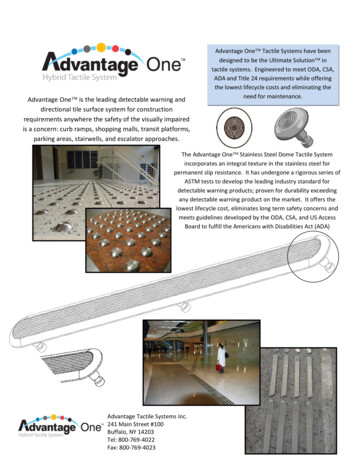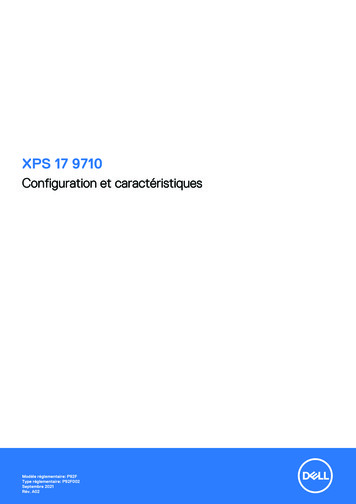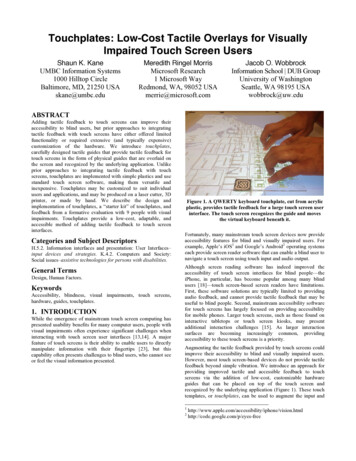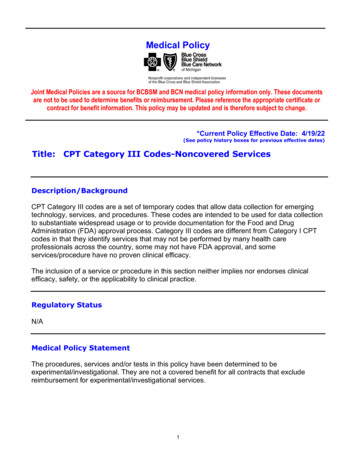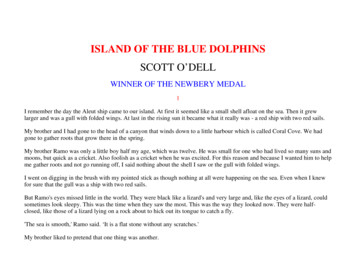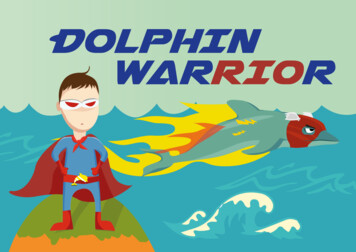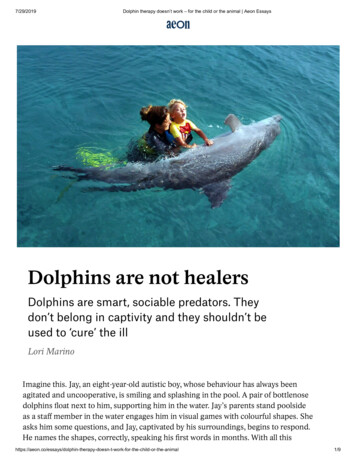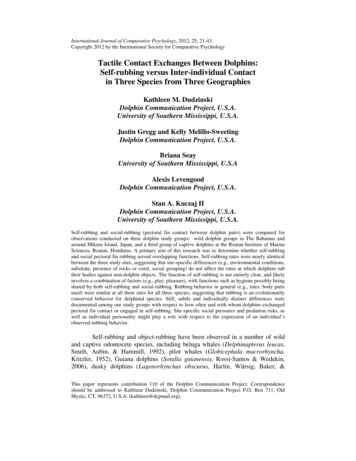
Transcription
International Journal of Comparative Psychology, 2012, 25, 21-43.Copyright 2012 by the International Society for Comparative PsychologyTactile Contact Exchanges Between Dolphins:Self-rubbing versus Inter-individual Contactin Three Species from Three GeographiesKathleen M. DudzinskiDolphin Communication Project, U.S.A.University of Southern Mississippi, U.S.A.Justin Gregg and Kelly Melillo-SweetingDolphin Communication Project, U.S.A.Briana SeayUniversity of Southern Mississippi, U.S.AAlexis LevengoodDolphin Communication Project, U.S.A.Stan A. Kuczaj IIDolphin Communication Project, U.S.A.University of Southern Mississippi, U.S.A.Self-rubbing and social-rubbing (pectoral fin contact between dolphin pairs) were compared forobservations conducted on three dolphin study groups: wild dolphin groups in The Bahamas andaround Mikura Island, Japan, and a third group of captive dolphins at the Roatan Institute of MarineSciences, Roatan, Honduras. A primary aim of this research was to determine whether self-rubbingand social pectoral fin rubbing served overlapping functions. Self-rubbing rates were nearly identicalbetween the three study sites, suggesting that site-specific differences (e.g., environmental conditions,substrate, presence of rocks or coral, social grouping) do not affect the rates at which dolphins rubtheir bodies against non-dolphin objects. The function of self-rubbing is not entirely clear, and likelyinvolves a combination of factors (e.g., play, pleasure), with functions such as hygiene possibly beingshared by both self-rubbing and social-rubbing. Rubbing behavior in general (e.g., rates, body partsused) were similar at all three sites for all three species, suggesting that rubbing is an evolutionarilyconserved behavior for delphinid species. Still, subtle and individually distinct differences weredocumented among our study groups with respect to how often and with whom dolphins exchangedpectoral fin contact or engaged in self-rubbing. Site-specific social pressures and predation risks, aswell as individual personality might play a role with respect to the expression of an individual’sobserved rubbing behavior.Self-rubbing and object-rubbing have been observed in a number of wildand captive odontocete species, including beluga whales (Delphinapterus leucas,Smith, Aubin, & Hammill, 1992), pilot whales (Globicephala macrorhyncha,Kritzler, 1952), Guiana dolphins (Sotalia guianensis, Rossi-Santos & Wedekin,2006), dusky dolphins (Lagenorhynchus obscurus, Harlin, Würsig, Baker, &This paper represents contribution 110 of the Dolphin Communication Project. Correspondenceshould be addressed to Kathleen Dudzinski, Dolphin Communication Project P.O. Box 711, OldMystic, CT, 06372, U.S.A. (kathleen@dcpmail.org).
Markowitz, 1999), and killer whales (Orcinus orca, Ford, 2009; Williams,Lusseau, & Hammond, 2006, 2009). These events consisted of rubbing on orotherwise physically touching objects and substrates. Possible functions of thesebehaviors include hygiene (e.g., parasite removal, sloughing), social (e.g.,affiliative, socio-sexual), and sensual (i.e., pleasure). In belugas, the occurrence ofrubbing on substrates is thought to facilitate the annual molting process (O'CorryCrowe, 2009). Kritzler (1952) hypothesized that object rubbing observed in captivepilot whales (including rubbing on a sea turtle) was done for sensual pleasure, butthat it might also serve a hygienic purpose in a wild setting. Rubbing on pebblebeaches, as observed in killer whales, potentially a cultural trait for specificpopulations (Whitehead, Rendell, Osborne, & Würsig, 2004), is thought tofacilitate parasite removal, or possibly play a social role (Ford, Ellis, & Balcomb,2000; Williams et al., 2009). For the Guiana dolphin, rubbing contacts with themuddy substrate were likely a consequence of feeding behavior (Rossi-Santos &Wedekin, 2006). Contact with objects such as buoys and seaweed may also be aresult of play behavior (Kuczaj, Makecha, Trone, Paulos, & Ramos, 2006).Unlike self-rubbing, social-rubbing (i.e., rubbing involving two or moreconspecifics) using the pectoral fin may serve primarily a social or social-sexualfunction (Dudzinski, Gregg, Ribic, & Kuczaj, 2009; Dudzinski, Gregg, Paulos, &Kuczaj, 2010). Pectoral fin contact (i.e., rubbing or touching involving the pectoralfin) has been observed in both wild and captive odontecete species. Wilddelphinids observed to exchange pectoral fin contact behavior include Indo-Pacificbottlenose dolphins (Tursiops aduncus, Dudzinski et al., 2009, 2010; Mann &Smuts, 1998, 1999; Sakai, Hishii, Takeda, & Kohshima, 2003, 2006a, 2006b),spinner dolphins (Stenella longirostris, Johnson & Norris, 1994), Atlantic spotteddolphins (Stenella frontalis, Dudzinski, 1996, 1998; Dudzinski et al., 2009, 2010),belugas (Smith et al., 1992), rough toothed dolphins (Steno bredanensis, Kuczaj &Yeater, 2007), and sperm whales (Physeter macrorhynchus, Whitehead &Weilgart, 2000). Species of captive dolphins observed to share pectoral fin contactinclude common bottlenose dolphins (Tursiops truncatus, Dudzinski et al., 2009,2010; Samuels, Sevenich, Gifford, Sullivan, & Sustman, 1989; Tamaki, Morisaka,& Tami, 2006; Tavolga & Esspian, 1957), spinner dolphins (Johnson & Norris,1994) and Commerson’s dolphins (Cephalorhynchus commersoni, Johnson &Moewe, 1999).Dudzinski (1998), Norris, Würsig, Wells, and Würsig (1994), and Sakai etal. (2006) suggested that pectoral fin rubbing is an affiliative behavior serving bothsocial and hygienic functions, similar to grooming behaviors in primates. Tavolgaand Essapian (1957) suggested pectoral fin rubbing was a passive form of sexualbehavior seen primarily in pre-copulatory situations. Additionally, Norris et al.(1994) observed rubbing of the abdominal and genital area by both wild andcaptive spinner dolphins and described it as a caressing behavior. Connor, Mann,and Watson-Capps (2006) suggested that contact swimming (defined as onedolphin’s pectoral fin touching another dolphin’s side) might function to reducemale harassment, assist in locomotion, or reduce stress between female IndoPacific bottlenose dolphins. Samuels et al. (1989) hypothesized that social-rubbingmay aid in the removal of ectoparasites and old epidermal cells, and noted that one- 22 -
observed individual dolphin which received infrequent rubbing from otherdolphins rubbed its body against objects in order to facilitate this process.The aim of this investigation was to examine whether self-rubbingbehavior might serve similar functions as pectoral fin rubbing. If, as Samuels et al.(1989) suggested, self-rubbing might serve as a proxy for social-rubbing, thensimilarities in the form of the rubbing behavior should be evident (e.g., body partbeing rubbed). Self-rubbing and pectoral fin rubbing behaviors from three distinctstudy populations are described and compared. Pectoral fin rubbing data from wildAtlantic spotted dolphins (Bimini, The Bahamas) are described here for the firsttime, supplementing data from captive bottlenose dolphins (Roatan Institute forMarine Sciences, Honduras) and wild Indo-Pacific bottlenose dolphins (MikuraIsland, Japan), which were previously described in Dudzinski et al. (2009, 2010).Self-rubbing data for all three study sites are presented for the first time. We usedthe same protocols and sampling techniques to collate both types of behavioralevents and then to compare data across study populations and between rubbingevent types. In addition to these comparisons, case studies from each populationare presented in order to describe similarities and differences between thesebehaviors as exhibited by individuals from the three study groups.MethodData collected on all study populations were part of a long-term, comparative examinationof dolphin communication (Beard, 2008; Dudzinski, 1996, 1998; Dudzinski et al., 2003, 2009, 2010;Gregg, 2008; Gregg, Dudzinski, & Smith, 2008; Melillo, 2008; Melillo, Dudzinski, & Cornick, 2009;Paulos, Dudzinski, & Kuczaj, 2007).Study Sites and PopulationsData were gathered from three locations over seven years (from 2003 to 2009) near Bimini,The Bahamas, around Mikura Island, Japan, and at RIMS (Roatan Institute for Marine Science),Anthony’s Key Resort, Roatan, Honduras. The Atlantic spotted dolphins (Stenella frontalis) arebelieved to be a resident population located near North Bimini, approximately 8-16 km from thecoastline, along the northwest edge of the Great Bahama Bank (Melillo, 2008; Melillo et al., 2009).This area ranges from 6 to 12 m in depth with a white sandy bottom and visibility typically at least 30m. Approximately, 90 individual dolphins have been identified with relative age categories and sexdetermined for most individuals (Melillo, 2008; Melillo et al., 2009; DCP unpublished data, 2001 2010).Approximately, 165 individual Indo-Pacific bottlenose dolphins (Tursiops aduncus) wereidentified within 300 m of Mikura Island, Japan, from 1997 – 2009 (Kogi, Hishii, Imamura, Iwatani,& Dudzinski, 2004; DCP unpublished data 1995 – 2009). Mikura lies roughly 200 km south ofTokyo, is a dormant volcanic island with a circumference of 16.4 km, and is characterized by aboulder-strewn seafloor with depths ranging from 2 to 60 m at 2 to 250 m from shore, respectively.Both the Mikura and Bimini study sites are adjacent to fish-productive, deep water (Marianas Trenchand Gulf Stream, respectively) and include dolphins ranging from calves to adults.RIMS is located on the northwest coast of Roatan, the center of three Bay Islandsapproximately 27 miles north of mainland Honduras. The bottlenose dolphin (Tursiops truncatus)study group ranges in age from neonate to 30 years and resides in a natural lagoon with a sea floorconsisting of natural coral, sea grass, and sand with depths from shore to 8 m. The enclosure has asurface area of roughly 300 m2. The age and sex distribution for this study group matches that ofmost coastal wild bottlenose dolphin study groups (Connor et al., 2006; Kogi et al., 2004).- 23 -
Data CollectionData were collected at all sites with a mobile video/acoustic system that permits underwaterreal-time synchronous video and audio recordings of dolphin behavior and vocalizations (Dudzinski,Clark, & Würsig, 1995). Limiting factors to underwater video-documentation include poor weather,sea, and visibility conditions. Protocols for video data collection from all study groups follow thoseoutlined in Dudzinski et al. (2009, 2010).Pectoral fin contacts and self-rubbing behaviors were coded only from videotaped data, forreliability. Event sampling for pectoral fin and self-rubbing contact among individual dolphins wasconducted from all video data gathered from each study site. Each contact event between onedolphin’s pectoral fin and another dolphin’s body (including the pectoral fin) was documented.Additionally, each contact event between an individual dolphin’s body part and any non-dolphinobject (self-rubbing) was documented. These objects could include the sea floor (sand, grass, coral),netting, floating objects. Other relevant, recorded data included date of occurrence, “real” time ofcontact, initiating dolphin’s identification, age and sex, receiving dolphin’s identification, age andsex, identity of rubber/rubbee role, each dolphin’s posture, duration of contact, whether contact was atouch or rub (for both pectoral fin and self-rubbing contact), and identification of the departingdolphin (for pectoral fin contact). For self-rubbing events, pertinent information listed above wasrecorded, and the object type was also noted.DefinitionsNumerous definitions of rubbing behavior exist in the literature (see Sakai et al., 2006a foran overview for pectoral fin contact). For this study, several definitions for pectoral fin contact wereemployed that have previously been defined in Dudzinski et al. (2009). Pectoral fin contact eventswere begun by one dolphin (either the rubber or rubbee) approaching and physically contactinganother dolphin, and were ended by one of the dolphins departing from the other. The rubber is thedolphin whose pectoral fin is the focus of the event, and the rubbee is the dolphin whose body isbeing contacted. In addition, either the rubber or the rubbee can be the initiator or the receiver of thecontact. For example, the rubbee may initiate contact with the rubber by approaching the rubber andsoliciting a rub by placing part of its body in contact with the rubber’s pectoral fin. Subsequently, therubber in this scenario is considered the receiver, and the rubbee is the initiator. The behavior wasfurther described as either a touch (i.e., static contact) or a rub (i.e., active movement between therubber’s pectoral fin and the rubbee’s body part).Self-rubbing was defined as a single dolphin contacting one or multiple body parts tosomething other than another dolphin (e.g., sea grass, garbage, sand). The behavior was described aseither a touch (i.e., static contact with the object) or a rub (i.e., active movement between thedolphin’s body part(s) and the object). Self-rubbing exchanges were begun by a dolphin approachingand physically contacting an object in the environment and ended when that dolphin departed or lostcontact with the object. For self-rubbing events, the single dolphin involved was by definition boththe rubbee and the initiator.For both pectoral fin contact and self-rubbing events, we divided the dolphin’s bodysurface into 11 parts to record the dolphin body part in contact with either a pectoral fin or an object(see diagrams in Dudzinski et al., 2009, 2010). Additionally, definitions for posture, age and sexfollow those presented in Dudzinski et al. (2009, 2010).Statistical AnalysesEven though a single animal might have contributed multiple pectoral fin contacts, or asingle animal engaged in multiple self-rubbing episodes in an encounter, we only included onecontribution per identified dolphin in the role of rubber and rubbee per encounter and only includedone self-rubbing episode per dolphin per encounter to ensure independence and randomness of thedata. Because data of the RIMS study group were collected in 30- or 60-min observation sessions, thedata were sub-divided into 3-min samples from which one contribution per identified dolphin asrubber, as rubbee and per self-rubbing behavior were included. Three minutes was the minimum timedefinition of an underwater encounter during observations of the wild study groups (Dudzinski, 1998;Dudzinski et al., 2009). Thus, from the total number of pectoral fin and self-rubbing contacts per siteper year of study, our sample size was limited to individual adjusted contacts.- 24 -
Because the return on effort between each of these three field sites differed greatly ( 8085% at RIMS compared with 5-15% at Bimini or Mikura), self-rubbing and pectoral fin contactrates were calculated by taking the total number of individual adjusted contacts per year per study sitedivided by the total effort (i.e., minutes of underwater video per site per year). Comparisons ofcontact rates (both self-rubbing and pectoral contacts) within and between sites were examined (usingindividual adjusted sample sizes) with a t-test with two samples assuming unequal variances. Bodypart and posture preference (using individual adjusted sample sizes) for both rubber and rubbee (forpectoral fin data) and the rubbee (for self-rubbing data) within and between sites was examined usingChi-square analysis. When comparing variables for self-rubbing and pectoral fin contact events, onlyevents involving the rubbee/initiator from the pectoral fin contact data were used to facilitate a faircomparison insofar as individuals involved in self-rubbing behavior could only be classified as arubbee/initiator. For self-rubbing data, Chi-square analysis was used to compare the proportion ofself-rubbing to pectoral fin contact between years and study sites. For pectoral fin contact data, Chisquare analysis was used to compare fin-to-fin versus fin-to-body contact, to assess variation inposture when the initiator was rubber versus rubbee, to compare the proportion of self-rubbing topectoral fin contact between years and study sites, to examine identification of sex/age in partnerpreference during contacts, rubbing versus touching for contacts, and initiator versus receiver roles.All Chi-square analyses were conducted with individual adjusted contact data.ResultsA collective total of 25 years of video data was examined to compare howdolphins from three distinct geographic regions use their pectoral fin(s) to sharecontact in comparison with how these same dolphins engage in self-rubbingbehavior. For pectoral fin data, video data ranged from a total 3,952 minutes from7 years near Bimini, The Bahamas, 1,208 minutes from 7 years around MikuraIsland, Japan, and 4,484 minutes from 6 years of data collected on the RIMS studygroup. For self-rubbing data, video data ranged from a total 3,952 minutes from 7years (Bimini), 3,261 minutes from 11 years (Mikura Island), and 5,134 minutesfrom 7 years (RIMS).Self-Rubbing BehaviorDolphins at each of the three field sites included in this study were oftenobserved to engage in self-rubbing, but to a lesser degree than they participated inpectoral fin tactile exchanges. Dolphins at Mikura engaged in self-rubbing a totalof 136 times during the study period; dolphins around Bimini engaged in 145episodes of self-rubbing; and dolphins at RIMS self-rubbed 182 times in total forthe study period.The mean contact rates for self-rubbing events at each site were: RIMS,0.03 SRB/min; Mikura, 0.03 SRB/min; Bimini, 0.05 SRB/min. T-tests reveal nosignificant differences in these rates: Mikura vs. RIMS: t(15) -0.067, p 0.05;Mikura vs. Bimini: t(14) -1.194, p 0.05; RIMS vs. Bimini: t(9) -1.338, p 0.05. The number of self-rubbing episodes by a single individual dolphin had amaximum range of 1-8 at Mikura (tied: TaIDs: 237, 404), 1-22 at Bimini (SfID87)and 1-25 at RIMS (Mika). Median duration in self-rubbing was similar betweensites (3 s at Mikura, 4 s at both Bimini and RIMS); however, episodes were longerat Bimini (x̄ 7 s, SD 10.5 s, range 1-67 s) than RIMS (x̄ 6.52 s, SD 9.5 s,range 1-91 s) and longer at RIMS than at Mikura (x̄ 4.77 s, SD 6.3 s, range 150 s). At Bimini, touches (N 96) and rubs (N 86) were roughly equal in use bydolphins when self-rubbing; however, dolphins at Mikura and at RIMS exhibited- 25 -
nearly twice as many rubbing (Mikura: touch N 48, rub N 88; RIMS: touch N 46, rub N 99) episodes as touch contact when self-rubbing.Comparison of self-rubbing across the three study sites revealed nodifference in overall frequency of self-rubbing between the three sites (X22 2.03,p 0.36); however, there were age and sex differences despite the lack of overallsite differences (Table 1). An analysis that combined study sites revealed thatjuveniles were most likely to engage in self-rubbing behavior (X22 113.62, p 0.001); however, this general finding is a bit misleading in that the relationshipbetween age and self-rubbing behavior varied across study sites. Self-rubbingbehavior was most likely among sub-adults at Mikura (X22 71.25, p 0.001),juveniles at Bimini (X22 87.24, p 0.001), and juveniles at RIMS (X22 121.47,p 0.001, Table 1). Adults were more likely to produce self-rubbing behavior atRIMS and Mikura than at Bimini (X22 13.89, p 0.001, Table 1), while subadults were more likely to engage in self-rubbing behaviors at Mikura than atBimini or RIMS (X22 70.50, p 0.001). RIMS and Bimini juveniles were morelikely to engage in self-rubbing than were Mikura juveniles (X22 41.51, p 0.001). In addition, Bimini calves produced more self-rubbing behaviors than didRIMS or Mikura calves (X22 50.53, p 0.001). In fact, Mikura calves were neverobserved engaging in self-rubbing behavior.Table 1Distribution of self-rubbing behavior observed by age and sex at three field 10180unID587518Collapsing across study sites, females were more likely than males toengage in self-rubbing bouts (X22 33.81, p 0.001). This was true for eachindividual study site as well: Mikura (X21 8.66, p 0.01; Bimini (X21 84.34, p 0.001), RIMS, (X21 8.57, p 0.01). However, the female advantage in selfrubbing was most evident in Bimini, where females produced over 94% of the selfrubbing events where sex was known.Dolphins from around Bimini assumed postures quite similar to thedolphins from RIMS when engaged in self-rubbing behavior, though dolphins atMikura seemed to assume both horizontal (HOR, N 38; lOSD1, N 23; rOSD, N 39) and vertical (HDO, N 29) postures each with similar frequency with theexception of HUP (N 1). Dolphins at Mikura did engage in HOR and rOSDpostures more than on their left side.Collapsing across study sites, dolphins self-rubbed with their rostrum more1Acronyms fully defined in Dudzinski et al. (2009): HOR is horizontal, lOSD is on left side, rOSD ison right side, HDO is vertical head down, HUP is vertical head up, and VTU is belly up, horizontal.- 26 -
than with all other body parts combined (X21 11.10, p 0.001); however, thisgeneral pattern did not hold across all three study sites. RIMS dolphins showed astrong preference for their rostrums during self-rubbing (X21 60.03, p 0.001),and it is their behavior that influenced the overall general trend described above.Bimini and Mikura dolphins used their rostrums more than any other body partduring self-rubs, but not significantly more so than all other body parts combined.In fact, Mikura dolphins were more likely to use another body part than to use therostrum (X21 9.22, p 0.01) despite the fact that the rostrum ranked first infrequency of occurrence during self-rubs.Pectoral Fin Contact – Bimini DataPreviously, we showed that mean pectoral fin contact rates betweendolphins at RIMS were not significantly different from those at Mikura (Dudzinskiet al., 2010). In order to compare contact rates for the new Bimini data, the RIMSand Mikura data were pooled. The mean contact rate for the pooled Mikura andRIMS sites was 0.35 contacts/min, while the mean contact rate at Bimini was 0.13contacts/min. A t-test revealed a significant difference in these rates (t(13) 3.592,p 0.003), suggesting that pectoral fin contact at Bimini is less frequent than atMikura and RIMS.Pectoral fin to pectoral fin vs. pectoral fin to body. Spotted dolphinsobserved around Bimini followed the trend of the same species in the northernBahamas (i.e., the White Sand Ridge study group (see Dudzinski et al., 2009)) andas the Mikura dolphins: they engaged in more pectoral fin to body contactregardless of their role as rubber and rubbee when identified as the initiatingdolphin (X21 6.09, p 0.05).Initiator vs. receiver. Similarly, spotted dolphins around Bimini exchangepectoral fin contact significantly more often as the initiator in the rubber role (X21 9.44, p 0.001). Wild dolphins (Mikura and Bimini) and captive (RIMS) dolphinswere similar in that the rubber was most likely to initiate contact with the pectoralfin at nearly identical rates.Body parts contacted. Pectoral fin contacts were scored according to thefrequency with which body parts were contacted by the initiator in the role ofrubber and rubbee at Mikura and RIMS (for sample sizes, see Table 1 fromDudzinski et al., 2010) and at Bimini for spotted dolphins during this study. Wedocumented 577 pectoral fin contacts among spotted dolphins at Bimini withrespect to body part contacted. To determine if the rubber or rubbee initiatescontact on similar body parts at Bimini as compared with dolphins from the otherstudy sites, body parts were ranked from most to least likely to be contacted foreach of these two conditions and compared with body parts contacted at each ofthe other field sites (Table 2; Dudzinski et al., 2010). Rubbee initiators fromBimini and Mikura contacted the same three body parts in the same order: face(B), side (C) and rostrum (A), and even though the order differed from that of thenorthern Bahamas and RIMS, the body parts were always the same three parts(Table 2). The side was also the primary body part contacted by rubbers asinitiators, as at all three other sites (Table 2; see also Dudzinski et al., 2009).Dolphins at Bimini contacted the peduncle more than dolphins at the other sites,- 27 -
but body part preference generally was consistent between dolphins at all fourstudy sites.Table 2Rank order (from most to least likely) of body parts contacted for the initiator in the role of rubberand rubbee for dolphins at Bimini, The Bahamas.RubberRubbeeCBKCFAHMBE, FDDL, ELAH, KG, MNote: G was not contacted when the rubbee was initiator at Bimini.Body postures. Similarly, spotted dolphins at Bimini significantly moreoften assumed the HOR posture as rubber or rubbee when exchanging pectoral fincontacts (X²5 16.245, p 0.01). Unlike results from either wild site, but similar toRIMS, when the HOR position, which accounts for 59.04% of postures observed atBimini, is removed from the dataset, a strong preference for specific positions isstill observed (X²4 14.223, p 0.01): HDO 35.25%; HUP 31.97%; lOSD 14.75%; rOSD 12.29%; VTU 5.74%, suggesting dolphins at Bimini arevertical more often than on one side or the other when exchanging pectoral fincontacts.As with our study at Mikura, White Sand Ridge (northern Bahamas) andRIMS, we examined Bimini data to determine whether two dolphins involved in apectoral fin contact episode assumed either same or different postures.Observations from Bimini are similar to results for the Mikura dolphins but notthose from White Sand Ridge or RIMS (Dudzinski et al., 2010): the initiatingdolphin as the rubber did result in both dolphins in the same posture more oftenthan was the case when the initiating dolphin was the rubbee (X²1 3.996, p 0.05).Sex and age. Dolphins at all field sites were categorized into four ageclasses: adult (A), subadult (S), juvenile (J) and calf (C). There was no significantdifference in the rate with which spotted dolphins at Bimini assumed the initiatorrole as rubber or rubbee for the four age classes (X²3 6.97, ns); however, morejuveniles and calves assumed the role of rubbee (X²3 28.18, p 0.0001) whenreceiving pectoral fin contact at Bimini (Table 3). Still, juveniles did assume therole of rubber as initiator more than twice that of adults or sub-adults (Table 3),and only marginally more than calves. While females assumed the role of rubberinitiator almost three times as often as males, and also the role of rubbee receiverabout 3.5 times that of males, these numbers were not significantly different from- 28 -
what was expected (Table 3). Still, the trend seems to be similar to that observed atthe other sites, with spotted dolphins at Bimini more often preferring same-sex,same-aged rubbing partners when sharing pectoral fin contact.Table 3Pectoral fin contacts by age class and sex for spotted dolphins at Bimini, the Rubber348rec.rubbee15538Note: INI is initiator; rec is receiverSelf-Rubbing Behavior vs. Pectoral Fin ContactSelf-rubbing contact occurred less frequently than pectoral fin contact forall three study sites. Significant differences in rates between the two contact typeswere found at RIMS (t(5) -6.178, p 0.002), Mikura (t(6) -3.893, p 0.008),and Bimini (t(7) -3.794, p 0.003). Mean rates for the study period for eachcontact type at each site were RIMS: 0.03 SRB/min, 0.29 PEC/min; Mikura: 0.03SRB/min, 0.40 PEC/min; Bimini: 0.05 SRB/min, 0.99 PEC/min.The age class and sex of dolphins (when known) involved in self-rubbingevents were compared to pectoral fin contact events for each study site. For thesecomparisons, only pectoral fin contacts involving the rubbee in the initiator rolewere used because self-rubbing events could only ever involve a dolphin classifiedas both rubbee and initiator. No significant difference was found in the proportionof males vs. females for the two rubbing event types for Mikura or RIMS. ForBimini, however, a significant difference in the proportions was found (X²1 100.52, p 0.001), with 94% of self-rubbing events being performed by females,but just 21% of females involved in pectoral fin contact exchanges as the rubbeeand initiator. A significant difference in the proportion of age classes involved inthe two rubbing event types was observed at RIMS (X²3 25.55, p 0.001),Mikura (X²3 13.2, p 0.004) and Bimini (X²3 18.42, p 0.001). At RIMS,subadults were more than twice as often involved in self-rubbing (47%) thanpectoral fin contact (21%). At Mikura, calves were involved in 13% of pectoralcontact exchanges as the rubbee and initiator, but were never observed selfrubbing. In contrast, at Bimini, calves were involved in 30% of self-rubbingevents, but just 10% of pectoral fin contact exchanges as rubbee and initiator.Dolphins at all sites seemed to preferentially use three body parts whenengaged in self-rubbing as compared to pectoral fin contact: the three body partscontacted most during self-rubbing included the rostrum (A), pectoral fin (H) andfluke (M). Body parts that rubbers contacted when initiating tactile interactionwere used when comparing these social contacts with self-rubbing. Combining allsites, dolphins were more likely to use their rostrums to rub when self-rubbing thanwhen rubbing another animal (X²1 139.92, p 0.001). Dolphins at RIMS (X²1 - 29 -
47.26, p 0.001), Mikura (X²1 20.57, p 0.001) and Bimini (X²1 78.04, p 0.001) were all more likely to use their rostrums during self-rubs than during social(pectoral fin exchanges) rubs
Dolphin Communication Project, U.S.A. University of Southern Mississippi, U.S.A. Self-rubbing and social-rubbing (pectoral fin contact between dolphin pairs) were compared for observations conducted on three dolphin study groups: wild dolphin groups in The Bahamas and around Mikura Island, Japan, and a third group of captive dolphins at the .

